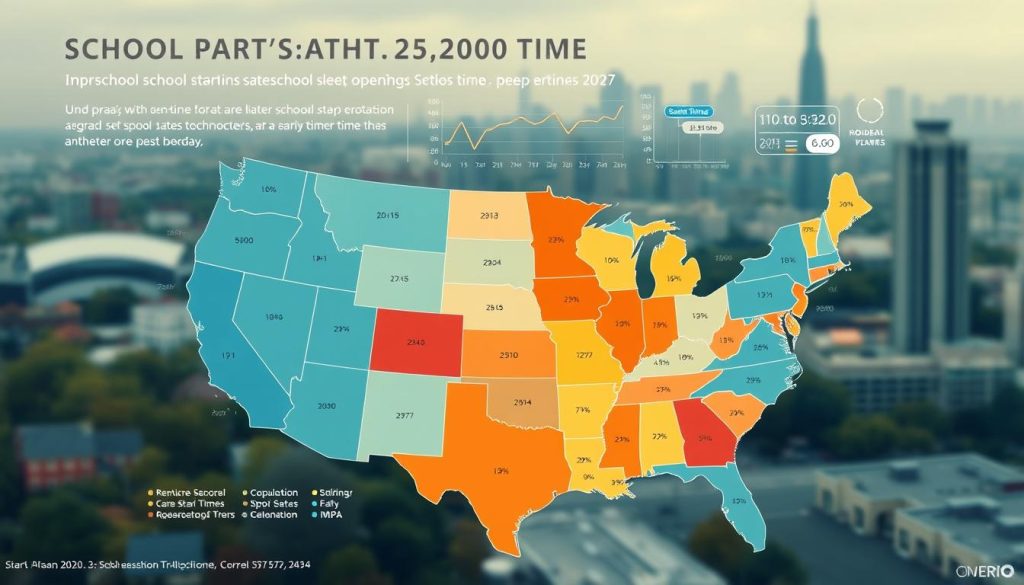Millions of teenagers in America face a daily battle every morning. Their natural sleep patterns don’t match the early school hours. This clash affects their learning and health.
During adolescence, our biological clock changes. Teens become more alert later at night and need more sleep in the morning. But most high schools start before 8:00 AM. This forces students to wake up when their bodies are tired.
This issue has become a concern for educators, parents, and health experts. Studies show that tired students have trouble focusing, remembering things, and doing well in school. They also face a higher risk of depression and anxiety.
But there’s hope. Small changes in school schedules can make a big difference. When schools start later, students sleep better, learn more, and feel healthier.
Learning about our biological clock helps us create better learning spaces for young people.
Understanding Circadian Rhythm in Teenagers
Every teenager has a biological timekeeper in their body. This timekeeper changes during adolescence. It affects sleepiness, alertness, hormone production, and brain function.
Chronobiology has shown us how sleep patterns change in teens. Their brains go through big changes that affect their sleep-wake cycles. These changes aren’t something teens can just will away.
What is Circadian Rhythm?
Circadian rhythm is your body’s 24-hour clock. It controls sleep, alertness, and other biological processes. It’s located in a small part of your brain called the suprachiasmatic nucleus.
During puberty, this clock shifts later. Teens naturally want to stay awake longer and sleep in later. It’s not laziness or bad habits – it’s biology.
Several factors influence circadian rhythm:
- Light exposure, especially blue light from screens
- Melatonin production timing
- Physical activity levels
- Meal timing and caffeine consumption
- Social and environmental cues
How It Affects Sleep Patterns
Teenagers often have delayed sleep phase syndrome. This makes it hard for them to fall asleep before 11 PM. Their brains don’t produce enough melatonin until later.

Biological changes make it tough for teens to get enough sleep. They need 8-10 hours of sleep each night. But their natural bedtime is later, and school starts early. This leads to a sleep debt that grows over time.
Common sleep changes in teens include:
- Difficulty falling asleep before 11 PM or midnight
- Natural wake time around 8-9 AM without alarms
- Increased alertness in the evening hours
- Grogginess and reduced function in early morning
- Weekend sleep-in periods to recover lost sleep
The Impact on Academic Performance
When teens fight their natural chronobiology, schoolwork suffers. Sleep-deprived students have trouble focusing, remembering things, and solving problems. These issues get worse over time, affecting their education.
Research shows that sleep is key to doing well in school. Well-rested students do better on tests, are more active in class, and solve problems better. The timing of sleep is as important as the amount.
Areas most affected by poor sleep timing include:
- Mathematics and analytical thinking
- Reading comprehension and language arts
- Creative problem-solving tasks
- Memory consolidation and recall
Knowing these facts helps us see that early school times clash with teen brain development. It’s not about teens going to bed earlier. It’s about matching school times with their natural sleep patterns.
The Importance of Sleep for Students
Every night of sleep is key for students to do well in school. It’s not just about feeling tired the next day. Sleep helps students learn, remember, and do well in school.
Studies show students who sleep well do better in school. They get better grades and participate more in class. Good sleep makes a big difference.

Connection Between Sleep and Learning
Sleep is important for the brain to process new information. During deep sleep, the brain makes memories last longer. This means students remember what they learned in class better.
The brain also gets rid of toxins while we sleep. Without enough sleep, students have trouble focusing and remembering things. They struggle to stay on track in class.
Good sleep helps students pay attention and stay focused. They can talk more in class and learn better. This is because they can concentrate for longer.
Consequences of Sleep Deprivation
Not getting enough sleep leads to many problems. Students face big challenges in school and health. It can really affect their school life.
Too little sleep weakens the immune system. Students get sick more often and miss school. They also can’t focus well when they’re in class.
Lack of sleep hurts mental health too. It raises the risk of depression and anxiety in teens. Students might feel moody, irritable, and stressed.
Not enough sleep also lowers grades. Students do worse on tests and assignments. They have trouble solving problems and thinking creatively.
Without enough sleep, students make bad choices. They might choose the wrong friends or take risks. This can lead to trouble in school.
Sleep Recommendations for Teens
Teenagers need 8-10 hours of sleep each night. But most teens don’t get enough. Good sleep habits can help.
Going to bed and waking up at the same time every day is key. This helps the body get into a routine. It’s important to do this even on weekends.
The bedroom should be cool, dark, and quiet for good sleep. Remove electronic devices at least an hour before bed. This helps the brain relax.
Good sleep habits include avoiding caffeine after 2 PM and not eating big meals before bed. Exercise during the day helps sleep, but not too close to bedtime.
A calm routine before bed signals to the brain that it’s time to sleep. This could be reading, stretching, or listening to music. The goal is to be consistent and choose relaxing activities.
Parents and students should work together to make sleep a priority. This means setting limits on homework and activities. Saying no to too much is sometimes necessary to protect sleep time.
Current Trends in School Start Times
A movement for later school start times is growing, but it’s not the same everywhere. School leaders are starting to see the value in matching school times with teens’ sleep needs. But, changing old habits to follow science is hard.
There are both good signs and tough spots in this change. Many schools are testing new times and listening to their communities. This careful step shows how hard it is to change long-standing ways of doing things.

Statistics from Schools Across the U.S.
About 75% of high schools in America start before 8:30 AM. This shows a big gap between what science says and what schools do. Only 18% of schools start as late as they should.
Start times vary a lot depending on where you are and how big the school is. Cities and bigger schools often change their times more than small towns and rural areas. They face bigger challenges in changing their schedules.
Interestingly, middle schools start even earlier than high schools in many places. Around 85% of middle schools start before 8:30 AM. This goes against research that says teens need more sleep during these years.
Recommendations from Health Organizations
The American Academy of Pediatrics suggests high schools start at 8:30 AM or later. They say this is key for students’ health. They point to studies that show better grades and health when schools start later.
The Centers for Disease Control and Prevention also backs these recommendations. They talk about how sleep affects teens’ health. Their studies show that not enough sleep can lead to many problems.
The American Medical Association agrees with later start times for teens. They say it’s because of teens’ natural sleep patterns. Doctors believe early school times go against these natural rhythms.
Case Studies: Schools That Changed Their Start Times
Seattle Public Schools moved high school start times to 8:45 AM in 2016. This led to better attendance and grades. Students got 34 minutes more sleep each night.
Minneapolis was one of the first big districts to start later in 1997. They’ve seen fewer dropouts and more graduates over the years. They’ve kept these times for over 20 years.
In California, some districts have also started later and seen good results. Schools report better focus and fewer problems. Parents and teachers have mostly supported the change after getting used to it.
Cherry Creek School District in Colorado is another success story. They slowly made the change, building support and solving problems. They’re now a model for other schools thinking about changing their times.
Benefits of Aligning Start Times with Circadian Rhythms
Schools with later start times see big improvements in student life. Studies show students do better when school times match their natural rhythms. This leads to better outcomes for students and the whole school.
Changes are seen quickly. Students are more alert and ready to learn. Teachers notice better classroom vibes and more student involvement.
Improved Attendance and Engagement
More students show up on time with later start times. Schools see a 3-5% boost in attendance. Students wake up easier, thanks to their natural rhythms.
Students are more engaged in class. Teachers see more active participation. Students ask more questions and join in discussions more.

Students interact better with each other. Group work and projects get a boost from their energy and focus.
Enhanced Mental Health and Well-Being
Mental health gets a big boost with later start times. Teenagers have less depression and anxiety. They feel less stressed about their day.
Students manage their emotions better with enough sleep. Mood swings lessen, and they handle challenges better.
Friendships grow stronger with more energy. Bullying drops in schools with later start times. Students feel more connected and happy.
The school feels more welcoming. Students feel part of the community. This leads to better well-being and happiness.
Academic Performance and Test Scores
Students do better in all subjects. They focus better and remember more. Homework gets done with more energy.
Test scores go up by 10-15% in math and reading. SAT and ACT scores also rise. Students do better in all areas.
Grade point averages improve for everyone. High-achievers and strugglers both see gains. This helps students succeed in school and beyond.
More students graduate with later start times. They stay interested in school. They learn to study and manage time better.
These early wins help students succeed in college and life. They keep healthy sleep habits for learning and growth.
Challenges in Changing School Start Times
Changing school start times to support adolescent health faces many barriers. Even when the science is clear, starting school later often meets resistance. This comes from cultural beliefs and logistical concerns that affect schools.
Success stories show that each district can overcome its own obstacles. Knowing these challenges helps communities prepare and find effective solutions.
Community Pushback and Cultural Norms
Many resist later school start times due to beliefs about early rising. The idea that “early to bed, early to rise” is key to success is deeply ingrained. This makes it hard to change to times that focus on adolescent health.
Working parents worry about childcare and how later times will affect their routines. They fear it will disrupt after-school jobs, sports, and family dinners. These are real challenges for families when school times change.
Some doubt that teenagers will just stay up later if school starts later. This doubt comes from not understanding how sleep patterns change during adolescence. Teaching about circadian rhythms helps address these concerns.
Transportation and Scheduling Concerns
School transportation is a big challenge for changing start times. Many districts use the same buses for different schools at different times. Changing high school times means reorganizing the whole system.
Rural districts face extra challenges due to long bus routes and limited resources. Some students ride buses for over an hour each way. Districts must balance health needs with transportation constraints.
Coordinating schedules across schools is complex. Elementary schools might need to start earlier if high schools start later. This raises concerns about younger children’s sleep needs. Finding solutions for all age groups requires careful planning and community input.
Policy Changes: What’s Needed?
Implementing later start times often needs policy changes at various levels. State education departments can offer guidance and support. Some states have laws encouraging or requiring later start times for health benefits.
Funding is a major policy concern. Changing transportation and extending school days can increase costs. Districts need financial help to implement new schedules without cutting programs. Federal and state funding can help cover these costs.
School board policies must evolve to prioritize student health and academic achievement. This includes updating policies on attendance, extracurricular activities, and staff contracts. Clear policies help districts manage the change process better.
Steps Toward Change: Advocacy for Parents and Educators
Changing school start times needs the effort of parents and educators working together. They must take strategic actions, build community, and keep pushing for better health and learning for students.
How Parents Can Get Involved
Parents should start by looking into their school district’s policies and studying student sleep patterns. Joining forces with other families strengthens their voice for change. Going to school board meetings and sharing research on teen sleep needs is key.
Setting up groups focused on student health can boost advocacy. Telling personal stories about how early school times impact families can resonate with decision-makers.
Engaging Educators and School Boards
Teachers and school leaders can lead the way by documenting how early start times affect students. Sharing sleep research in faculty meetings can gain support. Working with school counselors and nurses adds more insights on student health.
Creating materials that show the benefits of later start times can make a strong case for change.
Resources and Organizations for Support
Start School Later has tools and research for advocacy. The Sleep Foundation offers info on teen sleep needs. The American Academy of Sleep Medicine backs policy changes with science.
These groups provide webinars, fact sheets, and chances to connect with others who want to improve school schedules for better student health.

